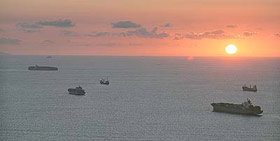 |
 |
 |
 News Around the Republic of Mexico | April 2005 News Around the Republic of Mexico | April 2005  
Major Port Proposed for Baja Region
 By Chris Kraul & Deborah Schoch - Los Angeles Times By Chris Kraul & Deborah Schoch - Los Angeles Times


| | Cargo ships sit outside the entrance to the Port of Long Beach, which has seen its traffic grow. Shippers say an increase in logjams warrants building a new port facility 150 miles south of Tijuana. (Photo: Gina Ferazzi / LAT) |
Mexico City — A coalition of shipping and freight concerns announced plans Friday for a $1-billion port on deserted seaside farmland about 150 miles south of Tijuana on the Baja peninsula. They hope to link the Mexican port to California with a new rail line connecting to the Imperial Valley and compete with the Los Angeles and Long Beach ports for a share of the multibillion-dollar West Coast shipping business.

If it materializes, the Punta Colonet facility would be one of the largest public works projects undertaken in Mexico, requiring the construction of roads, housing, public buildings and other infrastructure where none now exists.

The firms have begun lobbying the Mexican government, telling officials there would be enough cargo traffic and investment dollars to underwrite a major portion of the cost to build the port and a new city to serve it.

At stake is a share of the estimated $200 billion in revenue generated annually by shipping through California.

"We have to get Colonet developed," said Walter J. Romanowski, an executive with Los Angeles-based Marine Terminals Corp., a holding company owned by Evergreen and Yang Ming shipping lines of Taiwan, Hanjin of South Korea and China Shipping of Shanghai, all among the world's largest shipping firms. "There are no other viable West Coast options."

Romanowski said he wanted the right to build a complex of berths, warehouses and cranes that by 2012 could be running 1 million standard container units a year, about one-seventh the current volume at the Los Angeles port. Construction of the proposed Mexican port would take at least five years, the shipping companies say.

Port officials in Long Beach and Los Angeles said Friday that the project was news to them, although rumors have circulated for months about potential new port developments in Mexico.

Traffic at the two ports is so backed up that as many as 50 ships are kept waiting offshore as long as a week at a time. Environmental and other restrictions limit the ports' expansion, and other West Coast shipping terminals are becoming just as crammed.

Shipboard container traffic out of China is growing at an explosive rate — 15% or more per year — overwhelming the Long Beach and Los Angeles port complex, the world's third-largest.

Tie-ups at the L.A.-Long Beach ports last year sparked international anxiety when a flood of Asian cargo clogged docks, rail lines and highways, forcing giant container ships to idle offshore.

The logjam was blamed for delaying the delivery of holiday goods nationwide. Now, with January container traffic in Long Beach up 35% over last year, the shippers fear that such blockages could become an annual problem, forcing freighters to less congested ports in Seattle and British Columbia.

Southern California port officials worry about losses in jobs and revenue if shipping traffic shifts to competing regions.

But there is little room for the ports to grow. Expansion of the Los Angeles-Long Beach complex also is complicated by mounting community opposition. The twin ports are the region's largest source of air pollution.

The shipping industry soon will have no choice but to expand out of the Los Angeles Basin, and Mexico is the best alternative, said Al Fierstine, former Los Angeles port business development director who is now an advisor to Marine Terminals Corp.

Mexican Sen. Hector Osuna Jaime said the project would promote much needed growth in jobs and industry in Baja California. A new port, he said, would spur investors to build factories, possibly reversing a trend in recent years that has seen manufacturing jobs leave Mexico for China.

One political hurdle facing approval of the proposed port is the 150-mile rail link to connect with the United States. Mexican laws bar foreign ownership of such a line.

Also, Mexican officials traditionally authorize public works projects that they can see completed before their terms expire. President Vicente Fox leaves office at the end of 2006, long before the Punta Colonet project would receive its first ship.

The row over the California ports' environmental impacts spawned a proposal in Sacramento to limit emissions, as well as an ongoing initiative, launched by Los Angeles Mayor James K. Hahn, to slash Port of Los Angeles pollution to 2001 levels.

Last year's logjam of ships occurred just two years after the autumn 2002 lockout of dockworkers by the Pacific Maritime Assn., representing West Coast shipping lines.

At its worst, the 10-day lockout created a lineup of 129 ships waiting to deliver cargo at the Los Angeles-Long Beach complex.

Dockworkers' fears of losing jobs to automation helped spark the lockout, and some predicted a contract ratified by their union a few months later would mean a severe drop-off in high-paying longshore jobs.

Instead, the number of jobs increased, with 3,000 added at the complex.

Kraul reported from Mexico City and Schoch from Los Angeles. | 
 | |
 |



